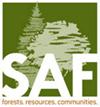美国西部国家森林木材供应和立木市场模型
IF 1.5
4区 农林科学
Q2 FORESTRY
引用次数: 0
摘要
本文提出了一个国家森林木材供应过程的综合区域模型,以及国家森林和非国家森林供应在确定区域立木价格和采伐量方面的相互作用。国家森林供应的内生要素包括评估价格、投标价格、已售和未售数量、合同未砍伐数量、已采伐数量和采伐价格的确定。该模型的组成部分描述了按投标价格和合同期限等级划分的销售量和采伐量的分布情况。对西部几个地区出价关系的估计结果表明,立木出价取决于产品价格和生产成本的短期(一年)分布滞后。在花旗松地区应用完整模型的结果表明,国家森林的短期供应在采伐价格方面可能比工业私人供应更具弹性。在 1977-1985 年期间价格和数量发生剧烈波动的时期,模型模拟以合理的准确度跟踪了花旗松地区立木市场的实际行为。在产品市场波动较小的情况下,模型对 2000 年的预测也显得合理且内部一致。For.科学》,35(2):401-424。本文章由计算机程序翻译,如有差异,请以英文原文为准。
A Model of National Forest Timber Supply and Stumpage Markets in the Western United States
This paper presents an aggregate regional model of the National Forest timber supply process and the interaction of National Forest and non-National Forest supply in the determination of regional stumpage prices and harvest volumes. Endogenous elements of National Forest supply include establishment of the appraised price, bid price, volumes sold and unsold, the uncut volume under contract, volumes harvested, and harvest price. Components of the model describe the distribution of volumes sold and harvested by bid price and contract duration classes. Estimation results for bid price relations in several western regions indicate that prices bid for stumpage depend on a short (one-year) distributed lag in product prices and production costs. Application of the full model in the Douglas-fir region suggests that short-term National Forest supply may be more elastic with respect to harvest price than industrial private supply. Model simulations track actual behavior in the Douglas-fir region stumpage market with reasonable accuracy over the period of extreme price and volume movements during 1977-1985. Model projections also appear reasonable and internally consistent in a projection to the year 2000 under a less volatile product market scenario. For. Sci. 35(2):401-424.
求助全文
通过发布文献求助,成功后即可免费获取论文全文。
去求助
来源期刊

Forest Science
农林科学-林学
CiteScore
2.80
自引率
7.10%
发文量
45
审稿时长
3 months
期刊介绍:
Forest Science is a peer-reviewed journal publishing fundamental and applied research that explores all aspects of natural and social sciences as they apply to the function and management of the forested ecosystems of the world. Topics include silviculture, forest management, biometrics, economics, entomology & pathology, fire & fuels management, forest ecology, genetics & tree improvement, geospatial technologies, harvesting & utilization, landscape ecology, operations research, forest policy, physiology, recreation, social sciences, soils & hydrology, and wildlife management.
Forest Science is published bimonthly in February, April, June, August, October, and December.
 求助内容:
求助内容: 应助结果提醒方式:
应助结果提醒方式:


